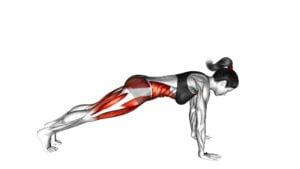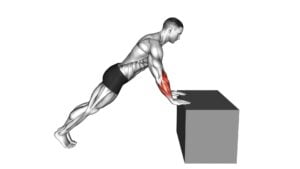Finger Raises Plank (male) – Video Exercise Guide & Tips

Get ready to take your planking game to the next level with Finger Raises Plank.
Watch This Exercise Video
In this video exercise guide, we'll show you how to perform this challenging variation with proper form and technique.
Whether you're a beginner or an experienced fitness enthusiast, we've got you covered with modifications and progressions to suit your level.
Avoid common mistakes, maximize your results, and get ready to feel the burn in your core and upper body.
Let's dive in and get those fingers raising!
Key Takeaways
- Increased stability and strength in core muscles
- Targets finger strength training
- Enhances grip strength for activities like weightlifting and rock climbing
- Improves overall posture and body control
Benefits of Finger Raises Plank
You will experience increased stability and strength in your core muscles by incorporating finger raises plank into your workout routine. This exercise is an effective way to target your finger strength training while also improving your core stability and balance.
During a finger raises plank, you'll be in a traditional plank position with your elbows bent and forearms resting on the ground. However, instead of keeping your palms flat on the ground, you'll lift your fingers off the floor, placing the weight onto your forearms and fingertips. This engages the muscles in your fingers, hands, and forearms, challenging them to support your body weight.
By incorporating finger raises plank into your routine, you can enhance your finger strength while simultaneously working on your core stability and balance. Strengthening your fingers is essential for various activities that require grip strength, such as weightlifting, rock climbing, or playing certain musical instruments. Additionally, improved core stability and balance can benefit your overall posture and body control.
To ensure proper form and technique during finger raises plank, it's important to maintain a straight line from your head to your heels, engaging your core muscles throughout the exercise. Keep your shoulders relaxed and avoid sagging or arching your back.
In the next section, we'll discuss the proper form and technique in more detail to help you get the most out of your finger raises plank workout.
Proper Form and Technique
How can you ensure proper form and technique during finger raises plank?
To perform finger raises plank correctly, start by assuming a standard plank position with your forearms on the ground and your body in a straight line from head to toe. Place your hands on the ground with your fingers pointing forward, and make sure your wrists are aligned with your shoulders. Keep your core engaged and your glutes squeezed throughout the exercise.
To execute the finger raises, lift one finger off the ground while maintaining a stable plank position. Hold for a few seconds, then lower the finger back down and repeat with the other fingers. This exercise targets the muscles in your forearms, hands, and shoulders, improving grip strength and stability.
For beginners, it's important to start with the basic finger raises plank variation. Begin by lifting one finger at a time, focusing on maintaining a strong plank position throughout. As you build strength and confidence, you can progress to lifting multiple fingers or even all fingers simultaneously.
Modifications and Progressions
To further challenge yourself and continue building strength, consider incorporating modifications and progressions into your finger raises plank routine.
If you're a beginner, it's important to start with modifications that allow you to gradually build up your strength and stability. One modification you can try is performing the finger raises plank on your knees instead of your toes. This will reduce the amount of body weight you have to support, making it easier to maintain proper form. Another modification is to perform the exercise against a wall or a sturdy surface, using it for support as you lift your fingers off the ground.
Once you have mastered the basic finger raises plank, you can start incorporating advanced progressions to further challenge yourself. One progression is to lift one leg off the ground while maintaining the plank position. This will increase the demand on your core muscles and improve your balance. Another progression is to perform the finger raises plank on an unstable surface, such as a Bosu ball or a foam pad. This will engage more muscles to stabilize your body and enhance the overall effectiveness of the exercise.
Remember to always listen to your body and progress at a pace that's comfortable for you. It's important to maintain proper form throughout the exercise and avoid any movements that cause pain or discomfort.
Common Mistakes to Avoid
To avoid common mistakes during the finger raises plank exercise, it's important to be mindful of your form and technique. Here are some tips for improvement:
- Lifting your hips too high: One common mistake is raising your hips too high, which takes away the engagement from your core muscles. To avoid this, keep your hips in line with your shoulders and heels.
- Allowing your back to sag: Another mistake is allowing your lower back to sag, which can put strain on your spine. To prevent this, engage your core muscles and maintain a straight line from your head to your heels.
- Neglecting proper hand placement: Incorrect hand placement can lead to wrist pain and instability. Make sure your hands are directly under your shoulders, with your fingers spread wide for better support.
By being mindful of these common mistakes and making the necessary adjustments, you can perform the finger raises plank exercise with proper form and technique, maximizing its effectiveness.
Now let's move on to the next section, where we'll discuss some tips for maximizing your results.
Tips for Maximizing Results
To maximize your results, incorporate these tips into your finger raises plank exercise routine.
Firstly, focus on pre-workout nutrition. Fueling your body with the right nutrients before exercising can enhance your performance and aid in recovery. Aim to consume a balanced meal or snack that includes carbohydrates for energy, protein for muscle repair, and healthy fats for sustained energy.
Additionally, make sure to prioritize recovery techniques. After completing your finger raises plank, take the time to properly cool down and stretch. This will help prevent muscle soreness and improve flexibility. Consider incorporating foam rolling or using a massage ball to release any tension in your muscles.
Another tip is to gradually increase the intensity and duration of your finger raises plank. Start with a comfortable level and gradually challenge yourself by increasing the number of repetitions or holding the plank for longer periods. This progressive overload will help strengthen your core and improve your overall fitness.
Lastly, listen to your body and give yourself enough rest days. Overtraining can lead to injuries and hinder your progress. Allow your muscles time to recover and rebuild by incorporating rest days into your workout routine.
Frequently Asked Questions
How Long Should I Hold the Finger Raises Plank Exercise For?
To get the most out of the finger raises plank exercise, it's important to hold it for the right amount of time. Proper form is crucial, so make sure to engage your core and keep your body in a straight line.
As for how long to hold it, start with 10 seconds and gradually increase the duration as you get stronger. Remember, there are also variations of this exercise that you can try to challenge yourself even more.
Can Finger Raises Plank Help Improve Grip Strength?
Finger raises plank is a great exercise for improving grip strength. By incorporating finger raises plank variations into your workout routine, you can target the muscles in your fingers, hands, and forearms, which will help strengthen your grip.
This exercise not only enhances your ability to hold objects but also improves overall hand dexterity. The benefits of finger raises plank go beyond just grip strength, making it a valuable addition to your fitness regimen.
Is It Necessary to Warm up Before Performing Finger Raises Plank?
Before performing finger raises plank, it's important to warm up your body to prevent injury and maximize the benefits of the exercise. Warming up increases blood flow and flexibility, preparing your muscles for the workout.
Finger raises plank is an effective exercise for improving grip strength and overall upper body strength. To properly perform this exercise, start in a plank position and raise your fingers one at a time, engaging your core and maintaining proper form throughout.
Can Finger Raises Plank Be Performed by Beginners?
Yes, finger raises plank can be performed by beginners. It's a challenging exercise that strengthens your core, arms, and fingers. To modify the exercise, you can start by doing knee push-ups instead of full plank. This will help build your strength and gradually progress to finger raises plank.
The benefits of finger raises plank include improved stability, enhanced grip strength, and increased upper body strength. Remember to listen to your body and start slowly to avoid injury.
How Often Should Finger Raises Plank Be Included in a Workout Routine?
Including finger raises plank in your workout routine depends on your fitness level and goals. As a general guideline, aim to perform this exercise 2-3 times per week. However, it's important to listen to your body and adjust the frequency accordingly.
Additionally, you can incorporate variations of finger raises plank, such as side planks or elevated planks, to challenge your muscles in different ways and keep your routine interesting.
Remember to consult with a professional trainer for personalized advice.
Conclusion
In conclusion, finger raises plank is a beneficial exercise that strengthens the core and improves stability.
It's important to maintain proper form and technique to maximize results and avoid common mistakes. By following the modifications and progressions, individuals can gradually challenge themselves and progress in their fitness journey.
Remember to listen to your body and make adjustments as needed. Incorporating finger raises plank into your workout routine can contribute to overall strength and stability.

Author
Years ago, the spark of my life’s passion ignited in my mind the moment I stepped into the local gym for the first time. The inaugural bead of perspiration, the initial endeavor, the very first surge of endorphins, and a sense of pride that washed over me post-workout marked the beginning of my deep-seated interest in strength sports, fitness, and sports nutrition. This very curiosity blossomed rapidly into a profound fascination, propelling me to earn a Master’s degree in Physical Education from the Academy of Physical Education in Krakow, followed by a Sports Manager diploma from the Jagiellonian University. My journey of growth led me to gain more specialized qualifications, such as being a certified personal trainer with a focus on sports dietetics, a lifeguard, and an instructor for wellness and corrective gymnastics. Theoretical knowledge paired seamlessly with practical experience, reinforcing my belief that the transformation of individuals under my guidance was also a reflection of my personal growth. This belief holds true even today. Each day, I strive to push the boundaries and explore new realms. These realms gently elevate me to greater heights. The unique combination of passion for my field and the continuous quest for growth fuels my drive to break new ground.







